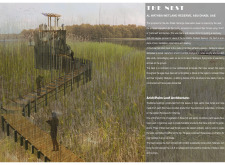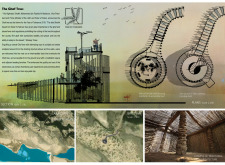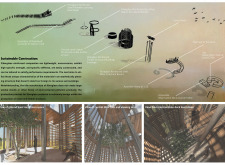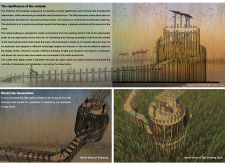5 key facts about this project
The Nest, located within the Al Wathba Wetland Reserve in Abu Dhabi, UAE, serves as an observation tower for flamingos. It provides spaces for rest, meditation, and nature observation while offering sweeping views of the wetlands. The design intertwines local cultural heritage with contemporary architectural ideas, emphasizing a deep connection to the natural environment.
Cultural Heritage Influence
The design takes inspiration from traditional “Arish” or palm leaf architecture found in Emirati culture. This influence is evident in the structure's form and function. By referencing majlis, which are gathering spaces in local communities, it creates an atmosphere that encourages social interaction and connection to the land. The design is rooted in the history of the region, allowing visitors to experience the rich cultural background of the area.
Spatial and Environmental Integration
The layout of The Nest is carefully designed to harmonize with its surroundings. A central Ghaf tree acts as both a focal point and a symbol of resilience, surrounded by pathways that direct light and create shaded areas for visitors. This arrangement offers a peaceful environment, making it suitable for both reflection and social activities. The structure is designed to blend in with the natural habitat, ensuring that it does not disturb the local wildlife, especially the flamingos, which rely on the wetlands for their survival.
Material Considerations
Materials play a crucial role in the structure's effectiveness and sustainability. Fiberglass reinforced composites are chosen for their lightweight and durable nature. These materials also offer resistance to corrosion, which is particularly important in the wetland environment. Using such materials helps the design balance traditional aesthetics with the practical needs of modern construction, leading to a building that is efficient and environmentally conscious.
Functional Design Features
The path leading to the observation tower is elevated, connecting it to existing trails in the wetlands. This pathway is designed for ease of access and fits into the landscape without disruption. It is made up of modular boardwalk elements that adapt well to varying ground conditions, making the site more navigable. The inclusion of lighting enhances safety and visibility in the evenings, creating an inviting environment for visitors without overshadowing the natural beauty of the wetlands.
The thoughtful arrangement of space and form culminates in a structure that encourages longer visits. It becomes a place for contemplation, interaction, and connection to the ever-changing landscape, inviting visitors to engage deeply with their surroundings.






















































